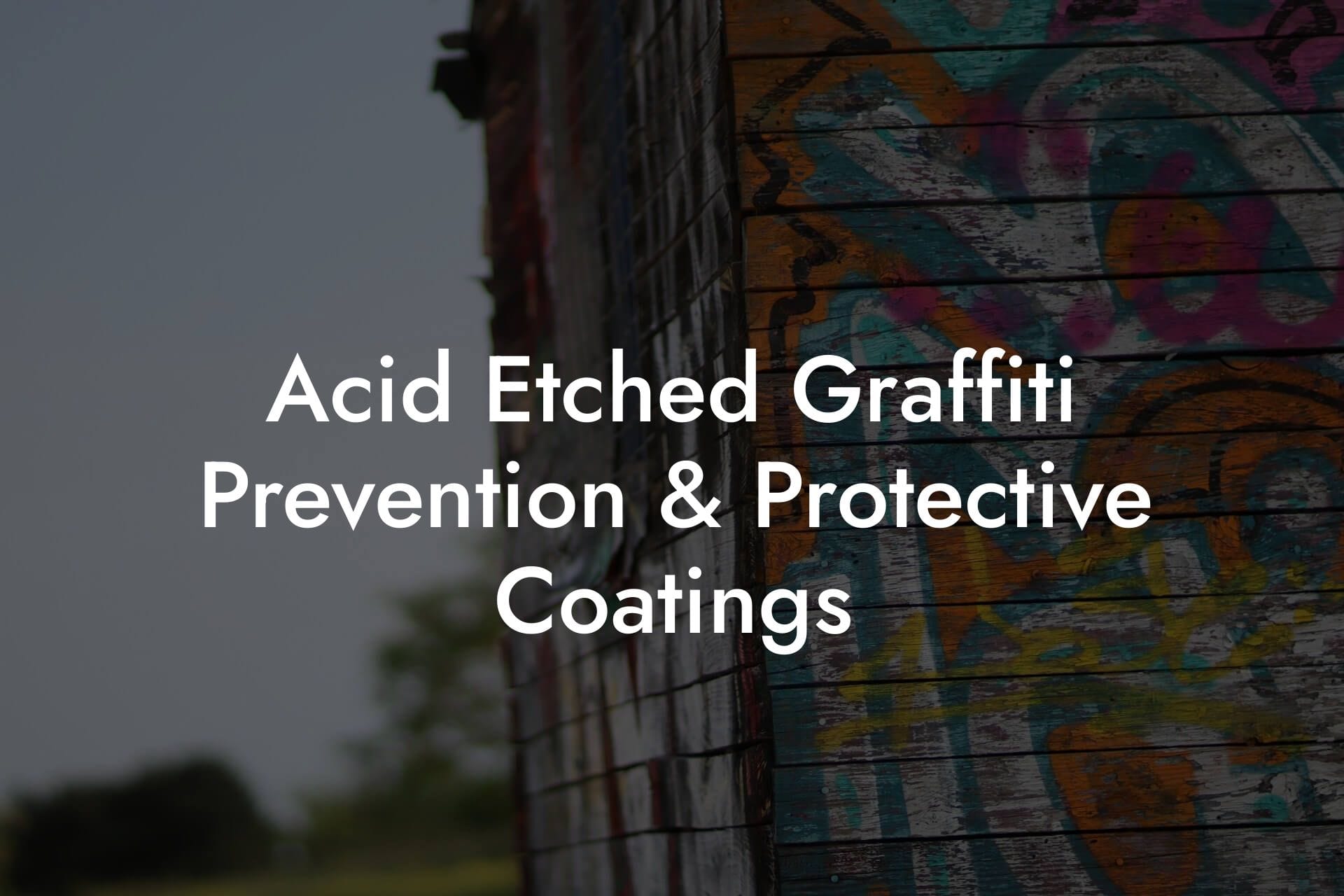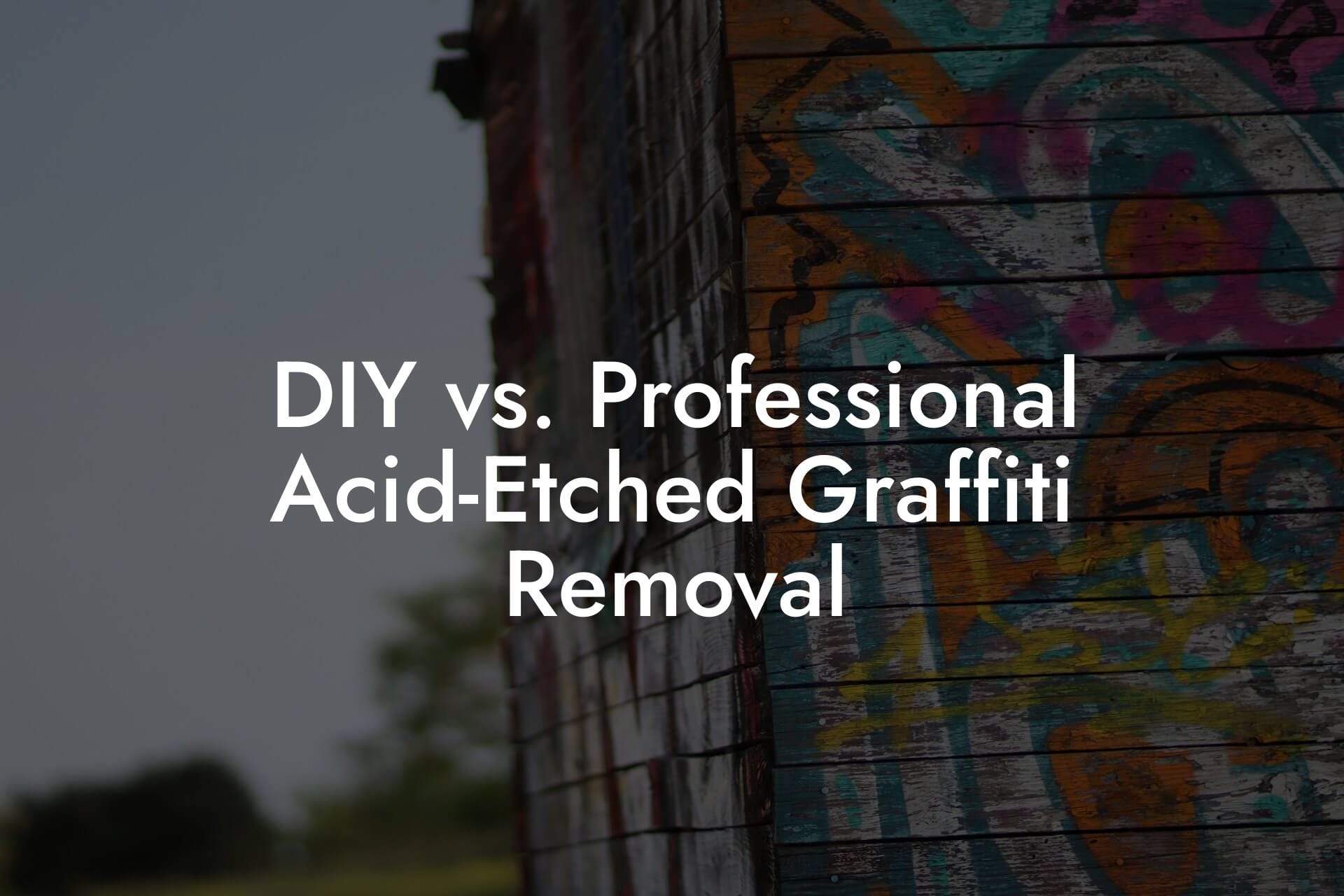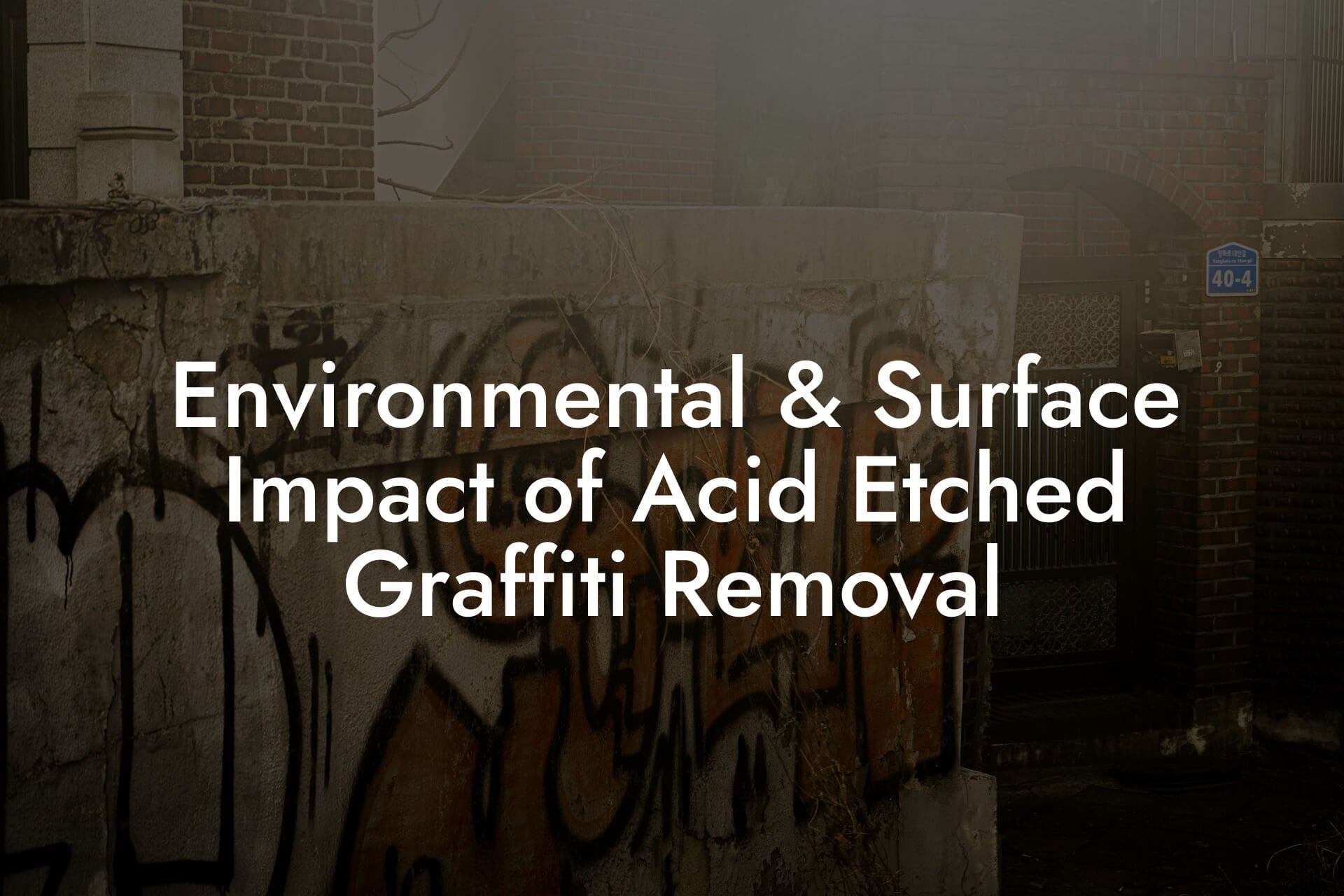Acid‑etched graffiti is one of the most destructive and insidious forms of vandalism affecting urban environments today. Unlike spray‑paint or marker tags that adhere to the surface, acid etching uses highly corrosive chemicals to permanently damage and discolor building materials at a molecular level. This guide will dive deeply, over 3,000 words, into every aspect of acid‑etched graffiti: the chemistry behind it, how vandals deploy acids, the types of surfaces most vulnerable, why it’s on the rise in London, how to identify it, and why professional intervention is essential. By the end, you will have a complete understanding of this threat and know exactly how to respond.
Table of Contents
- The Science of Acid Etching
- Fundamental Chemistry
- Acid Concentration & Dwell Time
- Visual & Tactile Differences
- Misidentification Risks
- Natural Stone
- Concrete, Brick & Mortar
- Glass, Ceramic & Metal
- Statistical Trends
- Urban Drivers
- Toxicology of Common Acids
- Required Personal Protective Equipment (PPE)
- Legal & Environmental Compliance
- Non‑Destructive Testing
- Spot‑Test Protocol
- Chemical Neutralization
- Mechanical Abatement
- Replacement & Recoating
- Protective Coatings
- Environmental Design
- Acid Etching vs. Surface Graffiti
- Substrate Vulnerabilities
- The Rise of Acid Etching in London
- Health & Safety Hazards
- Identification & Assessment
- Removal & Restoration Techniques
- Preventative Strategies
- Case Study: Historic London Facade
- Frequently Asked Questions
- Why Choose DUA London
- Conclusion & Next Steps
The Science of Acid Etching
Fundamental Chemistry
At its core, acid etching is a chemical reaction. Common acids used by vandals, hydrochloric, sulfuric, and hydrofluoric, break down the mineral matrix of building substrates. For example:
- Hydrochloric Acid (HCl): Reacts with calcium carbonate in limestone or mortar to form calcium chloride, water, and carbon dioxide:
CaCO₃ + 2 HCl → CaCl₂ + CO₂ + H₂O - Sulfuric Acid (H₂SO₄): Can link up with silicate minerals in concrete, producing gypsum (calcium sulfate), weakening the structure:
CaCO₃ + H₂SO₄ → CaSO₄ + CO₂ + H₂O - Hydrofluoric Acid (HF): Attacks silica networks in glass and ceramic:
SiO₂ + 6 HF → H₂SiF₆ + 2 H₂O
These reactions remove or alter the surface layer, leaving a pit, etch, or discoloration that cannot be simply washed away.
Acid Concentration & Dwell Time
Key variables determine depth and severity of etch:
- Concentration: Industrial‑grade (~30–37% HCl) vs. diluted (~5–10%) household grades.
- Dwell Time: How long the acid remains on the surface before neutralization or dilution by rain.
- Temperature & Humidity: Higher temperatures accelerate reaction rates; moisture can spread acid under coatings.
Vandals often balance these factors to maximize visible damage in minimum time.
Acid Etching vs. Surface Graffiti
Visual & Tactile Differences
Unlike paint, etched graffiti:
- Feels rough or pitted to the touch.
- Appears as lighter (bleached) or darker (oxidized) scars.
- Does not smudge, smear, or lift with solvents.
Spot testing with a mild abrasive pad confirms absence of pigment on the surface, the vandal has removed material, not applied it.
Misidentification Risks
Property managers sometimes mistake faint paint residue or aged marker ink for etching, leading to overuse of aggressive treatments that further damage substrates. A proper chemical and microscopic analysis is required for accurate diagnosis.
Substrate Vulnerabilities
Natural Stone
Limestone & Sandstone: High porosity and carbonate content, acid rapidly dissolves grain‑to‑grain bonds, leading to pitting and loss of surface detail.
Marble & Granite: Lower porosity, but marble’s calcium carbonate reacts readily; granite’s feldspar and quartz resist but silica‑rich minerals can still dull and pit under HF.
Concrete, Brick & Mortar
Concrete: Complex Ca‑Si‑O matrix reacts with acids to form soluble salts, washing away, leaving a weakened, crumbly surface.
Brick & Mortar: Acid penetrates mortar joints, loosening bricks. Clay faces lose binding and flake, causing a rough “scalloped” finish.
Glass, Ceramic & Metal
Glass & Ceramic: HF creates a frosted, translucent surface. Decorative glazes crack or craze.
Metals: Stainless steel pitting, anodised aluminium losing oxide film, mild steel rust spots where acid removed protective coatings.
The Rise of Acid Etching in London
Statistical Trends
In the past five years, acid‑etched incidents reported to local councils have doubled. Transport for London (TfL) data shows a 40% rise on Underground station façades alone. DUA London has responded to over 500 acid graffiti calls in 2024, a 25% increase year‑on‑year.
Urban Drivers
- Accessibility: Acids easy to conceal in bottles or spray containers; fast‑acting, so vandals can flee quickly.
- Perceived Permanence: A belief that acid marks “last forever” makes them a status symbol among vandal circles.
- Low Enforcement: Standard cleaning crews lack training to identify or safely neutralize acids.
Health & Safety Hazards
Toxicology of Common Acids
- HCl: Corrosive to skin and eyes; inhalation can damage respiratory tract.
- H₂SO₄: Generates heat on contact with water; risk of thermal burns and splatter injury.
- HF: Penetrates tissue deeply; systemic toxicity by binding calcium in bones, can be fatal.
Required Personal Protective Equipment (PPE)
- Chemical‑resistant gloves (nitrile or neoprene).
- Full‑face shield plus goggles underneath.
- Acid‑resistant suits and aprons.
- Respirators with acid gas cartridges (A2).
Emergency calcium gluconate gel on hand for HF exposure.
Legal & Environmental Compliance
Under UK COSHH regulations, handling and disposal of hazardous waste must be documented. Neutralized acid solutions often remain corrosive; pH must be monitored (pH 6–9) before discharge.
Identification & Assessment
Non‑Destructive Testing
- pH indicator swabs: reveal presence of residual acid or salts.
- Moisture meters: detect acid penetration depth by conductivity.
- Portable spectrophotometers: assess discoloration and depth of bleaching.
Spot‑Test Protocol
- Clean small area with deionized water.
- Apply weak neutralizer (e.g., lime slurry) in a contained boundary.
- Monitor effervescence and pH change to infer acid strength and penetration.
These steps inform method selection: mechanical reprofiling vs. chemical neutralization vs. total substrate replacement.
Removal & Restoration Techniques
Chemical Neutralization
Involves applying alkaline solutions to convert residual acid into harmless salts:
- Ammonia or sodium bicarbonate slurries.
- Specialized chelating agents for metal substrates.
Requires multiple applications and thorough rinsing to avoid salt crystallization under surface coatings.
Mechanical Abatement
- Micro‑Sandblasting: Abrasive media (silica‑free) under low pressure to remove etched layer millimeter by millimeter.
- Diamond Grinding & Polishing: For stone and concrete, restores flatness and smooth finish, but removes several millimeters of material.
Replacement & Recoating
When damage exceeds safe remediation depth (e.g., >3 mm), panels or stones may need full replacement. Decorative coatings, breathable siloxane sealers or sacrificial coatings, can then be applied to protect against future chemical attack.
Preventative Strategies
Protective Coatings
Two main types:
- Sacrificial Coatings: Clear, peelable films that capture graffiti and acids, removed and reapplied periodically.
- Permanent Repellents: Silane/siloxane sealers that reduce porosity and impede acid uptake.
Environmental Design
- Improved lighting and CCTV deter vandals.
- Landscaping buffers (spiky plants, low fences) limit easy access to vulnerable façades.
- Community engagement: graffiti walls and legal art spaces redirect vandalism into sanctioned outlets.
Case Study: Historic London Facade
Background: Grade II‑listed limestone façade at a Bloomsbury townhouse defaced with acid‑etched tag.
Assessment: Depth up to 2 mm; widespread pore contamination.
Solution: Three rounds of sodium bicarbonate neutralization, followed by micro‑sandblasting and diamond polishing. Final application of breathable siloxane sealer. Total downtime: 2 days, cost savings of 30% vs. full stone replacement.
Frequently Asked Questions
Can acid‑etched graffiti reappear after cleaning?
Yes, if residual salts remain, they can migrate and re‑bleach surface. Complete neutralization and thorough rinsing are essential.
How long does professional removal take?
Small tags (<0.5 m²) typically require 2–4 hours; larger installations or deep etching may need multiple days and specialized equipment.
Is DIY removal possible?
Amateur attempts often worsen damage. Without industrial neutralizers, correct abrasives, and safety gear, you risk health hazards and further surface loss.
Why Choose DUA London
- 24/7 Rapid‑Response Teams across all London boroughs.
- Trained in COSHH compliance, using industry‑approved chemicals and methods.
- Full site surveys with non‑destructive testing before any work begins.
- Post‑treatment warranties on coatings and restoration work.
Conclusion & Next Steps
Acid‑etched graffiti represents not just a cosmetic nuisance but a serious threat to the longevity and safety of building materials. Its removal demands scientific understanding, specialized equipment, and rigorous safety protocols. DUA London stands ready to assess, neutralize, and restore your property, ensuring minimal disruption and maximum protection.
Ready to regain control of your façade? Contact DUA London now for a free, no‑obligation site survey and fast, professional acid‑etched graffiti removal.
Toby Doherty
Toby Doherty is a seasoned graffiti removal expert with over 20 years of experience in the industry. Throughout his career, Toby has helped countless businesses and property owners in London maintain clean, graffiti-free spaces. His extensive knowledge of graffiti removal techniques, from eco-friendly solutions to advanced technologies like laser cleaning, makes him a trusted authority in the field. Passionate about restoring urban environments, Toby combines his hands-on expertise with a commitment to staying up-to-date on the latest industry trends and innovations. When he’s not out in the field, Toby shares his insights through detailed articles, offering practical advice on everything from graffiti prevention to legal considerations.



